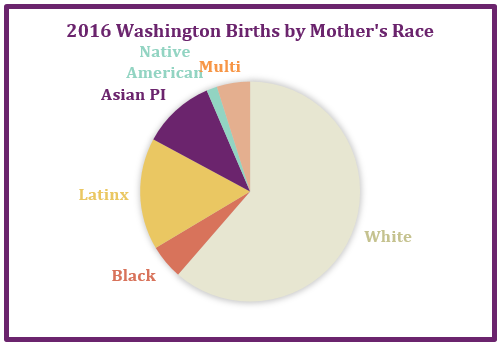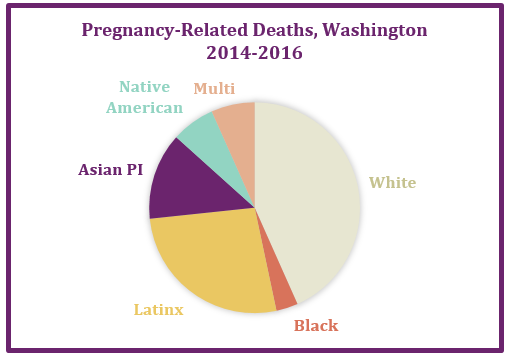For a PDF, click here.
High rates of maternal mortality and pregnancy-related health complications are a national crisis reflecting large racial disparities. In Washington State, Native American and Latina women are particularly likely to die of pregnancy-related causes. Other health complications are also common in the months following childbirth. One common sense step Washington can take to address this crisis is to extend Apple Health Pregnancy Medical coverage from two months to a full year after childbirth.
The Maternal Mortality Health Crisis
Pregnancy-related mortality is a global crisis. In the United States, maternal mortality rates (MMR) have been steadily rising since the year 2000. The U.S. now has the highest rate globally among wealthy nations.[1]
In addition to being a healthcare issue, pregnancy-related mortality is a racial equity issue. Black women have had disproportionately high MMRs compared to White women in the United States (figure 2).[2] In 2017 in the U.S., Black women were three times more likely to die from pregnancy-related causes than White women. This discrepancy has been consistent over the past two decades.[3]
Background in Washington
Washington’s Maternal Mortality Review Panel (MMRP) has found that pregnancy-related health in the state echoes the national crisis, but illuminates different trends. Washington has a current annual rate of 11.2 deaths per 100,000 births—less than the national MMR, but an alarming number nonetheless.[4]
Statewide as nationally, stark racial disparities exist in the rates of pregnancy-related complications. In 2018, there were about 92,000 births in Washington. Among those giving birth, 71 percent were White, 19 percent were Latina, and 5 percent were Black.[5] Latina women were twice as likely to die from pregnancy-related causes as Whites, and American Indian and Alaska Natives were 6 to 7 times more likely.[6] In addition, babies born to Black mothers had a stillbirth rate of 9.7 and an infant mortality rate of 7.1 per 1,000 births, compared to rates of 5.3 and 4, respectively, for infants of White mothers.[7]
The causes of these disparities are complex, and rooted in intersections of race, gender and economic inequality, as well as discrimination in the healthcare system and the nation in general. Across racial demographics, common post-pregnancy complications include cardiovascular disease, blood clots, infection, and postpartum depression. According to the Centers for Disease Control and Prevention, lack of access to quality health care and missed diagnoses contribute to maternal deaths – and 3 in 5 nationally could be prevented.[8]
Nearly half of the births in Washington in 2018 were covered by Medicaid, indicating low incomes. Of those on Medicaid, 40 percent were White, 71 percent were Black, and 80 percent were Latina.[9] A policy solution to the pregnancy-related health crisis must consider the needs of Women of Color, in addition to poor, immigrant, rural, and medically underserved populations – in other words, many of those using Medicaid.

Source: U.S. Census Bureau, American Community Survey 2016, Table S1301
Policy Response
We can take relatively simple steps here in Washington to improve health outcomes. Legislation considered in the 2020 session (Senate Bill 6128) responds to pregnancy-related health risks by extending Apple Health coverage to a full year postpartum.[10] Currently in Washington, Apple Health for Pregnant Women covers pregnant women with incomes up to 198 percent of the federal poverty level (FPL), regardless of citizenship status, through their pregnancy and until two to three months postpartum. Coverage extends for 60 days plus any days left in the month, with an absolute cap at three months.[11]
After 60 days postpartum, women with incomes below 138 percent FPL can remain covered by Apple Health. However, those with incomes between 138 percent and 198 percent FPL or who have undocumented immigrant status lose coverage. Nearly 10,000 women fall in these categories.[12] While non-immigrants can theoretically purchase healthcare on the Exchange, this option can be financially unattainable and emotionally challenging, and interferes with the continuity and quality of care that a new parent receives. In the first year after childbirth, new parents should be able to focus on their own health and wellness and that of their child, without the added burden of healthcare logistics.

Source: Washington Department of Health, Maternal Death Report 2014-2016
The findings of the Washington state MMRP demonstrate a need for Apple Health coverage for an entire year postpartum. The panel found that 30 percent of pregnancy-related deaths in the state from 2014 to 2016 occurred 43 to 365 days after delivery. Death due to behavioral health conditions, such as suicide and depression, occurred on average 157 days post-birth.[13] The six-week checkup recommended by obstetricians falls dangerously close to the 60 day cut-off as well, leaving healthcare providers insufficient time to address depression and other health risks.[14] Too much of the risk of both pregnancy-related deaths and other serious pregnancy-related health conditions falls outside that crucial window that is currently covered by Apple Health Pregnancy Medical.
Senate Bill 6128 includes the entire birthing population, which includes women regardless of immigration status, as well as Trans and gender nonconforming people who become pregnant in Washington. The lack of gender-inclusive data, as well as privacy and statistical significance concerns when collecting data in very small populations, underscores the need for focused and inclusive policy development for people of all gender identities.
Frameworks for Addressing the Issue
We can look beyond Washington to see solutions that work. The Center for American Progress published a “comprehensive policy blueprint” in 2019, to outline their agenda for addressing pregnancy-related health disparities. They acknowledge the need for continuous postpartum care, suggesting enhanced support for families after birth by investing in programs that offer one-stop comprehensive services.[15]
At the federal level, the Helping Medicaid Offer Maternity Services Act is a bipartisan bill which, if passed, would give states the option to extend Medicaid one year postpartum, and provide a 5 percent increase in federal matching to support the extension.[16] If the Washington Legislature passes a bill extending Medicaid coverage, it will prepare the state to receive this enhanced federal match, and pave the way for other states looking for solutions to their own pregnancy-related health crises.
The diversity of MMRs across states can also aid in understanding possible solutions. California, for example, has the lowest rates in the country, and can serve as a model for reform in Washington. From 2006 to 2013, maternal mortality decreased by 55 percent in California while the national rate continued to rise, indicating the effectiveness of the state’s approach thus far. Through the California Maternal Quality Care Collaborative (CMQCC), the state has implemented an online Maternal Data Center that provides hospitals with access to near real-time data about perinatal performance and improvement insights. With over 200 hospitals participating, 95 percent of births in California interact with this system. In conjunction with continued research, the CMQCC has also developed evidence-based quality improvement toolkits for leading causes of preventable pregnancy-related death and complications.[17] Through a legislative victory in 2019, California passed a bill which extends Medi-Cal (California Medicaid) to one year postpartum.[18]
Washington can heed the models of states like California to both address pregnancy-related mortality and healthcare concerns locally, and pave the way for solutions nationwide. With an understanding of healthcare inequity, Senate Bill 6128 addresses the overall crisis by supporting those in our state who are the most vulnerable.
Endnotes
[1] World Health Organization, UNICEF, UNFPA, World Bank Group and UNPD (September 2019). Maternal Mortality. Retrieved from https://data.unicef.org/topic/maternal-health/maternal-mortality/.
[2] The word “women” is used in this paper to refer to the entire birthing population, although we recognize that some people who give birth identify as Trans and gender non-conforming. Unfortunately, gender identity information is not yet being collected in people giving birth, making data difficult to access and analyze.
[3] Centers for Disease Control and Prevention (December 2018). National Center for Health Statistics: Underlying Cause of Death 1999-2017 Request. Retrieved from http://wonder.cdc.gov/ucd-icd10.html.
[4] Andino, V., Bates, A., Buck, T. and Lazariu, V. “Washington State Maternal Mortality Review Panel: Maternal Deaths 2014-201,” Washington State Department of Health, Prevention and Community Health Division, October, 2019: https://www.doh.wa.gov/Portals/1/Documents/Pubs/141-010-MMRPMaternalDeathReport2014-2016.pdf
[5] U.S. Census Bureau, American Community Survey, 2018.
[6] Andino, V., Bates, A., Buck, T. and Lazariu, V. “Washington State Maternal Mortality Review Panel: Maternal Deaths 2014-201,” Washington State Department of Health, Prevention and Community Health Division, October, 2019: https://www.doh.wa.gov/Portals/1/Documents/Pubs/141-010-MMRPMaternalDeathReport2014-2016.pdf
[7] Washington Health Care Authority, Birth Statistics, Infant and fetal mortality: https://www.hca.wa.gov/assets/program/infant_fetal_mortality_over_time.pdf
[8] Centers for Disease Control and Prevention, “Pregnancy-Related Deaths Happen Before, During, and Up to a Year After Delivery,” Press release, May 7, 2019, https://www.cdc.gov/media/releases/2019/p0507-pregnancy-related-deaths.html
[9] Washington Health Care Authority, Characteristics of all women who gave birth report:
https://www.hca.wa.gov/assets/billers-and-providers/characteristics-women-washington-state.pdf
[10] Senate Bill 6128, State of Washington: http://lawfilesext.leg.wa.gov/biennium/2019-20/Pdf/Bills/Senate percent20Bills/6128-S.pdf?q=20200128122340
[11] Washington Health Care Authority, Health Services and Supports, Pregnant women: https://www.hca.wa.gov/health-care-services-supports/apple-health-medicaid-coverage/pregnant-women
[12] Washington State Multiple Agency Fiscal Note Summary, SB 6128, “Postpartum period/Medicaid,” February, 2020: https://fortress.wa.gov/FNSPublicSearch/GetPDF?packageID=59951
[13] Andino, V., Bates, A., Buck, T. and Lazariu, V. “Washington State Maternal Mortality Review Panel: Maternal Deaths 2014-201,” Washington State Department of Health, Prevention and Community Health Division, October, 2019: https://www.doh.wa.gov/Portals/1/Documents/Pubs/141-010-MMRPMaternalDeathReport2014-2016.pdf
[14] “Optimizing Postpartum Care,” American College of Obstetricians and Gynecologists, May 2018: https://www.acog.org/Clinical-Guidance-and-Publications/Committee-Opinions/Committee-on-Obstetric-Practice/Optimizing-Postpartum-Care
[15] Taylor, J., Novoa, C., Hammand, K., & Phadke, S. “Eliminating Racial Disparities in Maternal and Infant Mortality,” May 2019: https://www.americanprogress.org/issues/women/reports/2019/05/02/469186/eliminating-racial-disparities-maternal-infant-mortality/.
[16] House of Representatives 4996, United States Congress: https://www.congress.gov/116/bills/hr4996/BILLS-116hr4996ih.pdf
[17] California Maternal Quality Care Collaborative: https://www.cmqcc.org/
[18] Assembly Bill 577, State of California: https://leginfo.legislature.ca.gov/faces/billTextClient.xhtml?bill_id=201920200AB577
More To Read
November 1, 2024
Accessible, affordable health care must be protected
Washington’s elected leaders can further expand essential health care
September 10, 2024
Big Corporations Merge. Patients Pay The Bill
An old story with predictable results.
July 31, 2024
New poll in Washington finds people struggling with health care costs at an alarming rate
More than half (57%) of respondents have avoided seeking medical treatment or modified their use of prescriptions in the last year due to the cost
